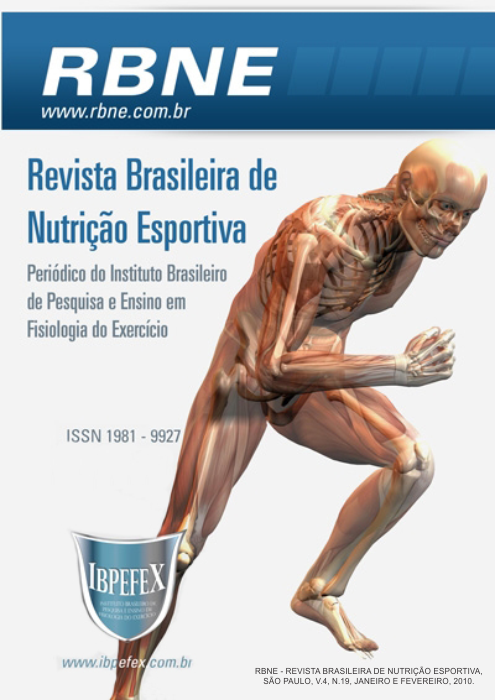Alterações do peso corporal (nível de desidratação) e da frequência cardíaca antes e após uma aula de bike indoor
Resumo
Objetivo: Analisar a variação de freqüência cardíaca e comparar o peso corporal antes e após a sessão de bike indoor para verificar o nível de desidratação corporal. Metodologia: A pesquisa caracteriza-se como uma pesquisa pré-experimental com delineamento pré e pós-teste. A amostra deste estudo foi de n = 15 alunos de bike indoor, escolhido por atender os seguintes critérios de inclusão: tempo de prática de no mínimo seis meses, idade entre 18 e 63 anos e freqüência nas aulas de no mínimo 3 vezes na semana. As variáveis analisadas foramo peso corporal antes e após o exercício, e a freqüência cardíaca foi mensurada a cada 5 minutos durante toda a sessão. A aula analisada neste estudo foi de 45 minutos, dividida em exercícios de aquecimento na bicicleta estacionaria durante 6min, em seguida os participantes trabalharam entre 60% e 90% da freqüência cardíaca máxima (%FCM) durante o restante da sessão. Resultados: A faixa etária apresenta média de idade de 29,1 ± 12,2. A freqüência cardíaca de repouso (FC rep) dos amostrados apresenta média de 69,2 ± 4,1bpm. A freqüência cardíaca máxima (FC max) apresenta média de 187,65 ± 8,51bpm. Na análise do peso corporal, observa-se uma redução média de -1,45% do peso total. Conclusão: Os dados obtidos neste estudo permitem apontar que a aula de bike indoor, alterou o peso corporal estatisticamente significativo, com queda de –1,45% podendo levar a desidratação. Na análise da FC, a aula de bike indoor alterou a FC, oscilando em aumento e diminuição ao longo da aula.
Referências
-Almeida, M. Frequência cardíaca e exercício: uma interpretação baseada em evidências. Rev Bras Cineant Des Hum.Vol. 9. Num.2. 2007.
-Batista, M.A.L.;FernadesFilho J.;e Dantas, P.M.S. A influência da intensidade de treinamento e a perda de peso corporal. Fit Perf J.Vol.6. Num.4. 2007. p.251-254.
-Escobar, M.;e colaboradores. Comparação entre ingestão hídrica e percentual de desidratação em jogadores de futebol em dias distintos. Rev Bras Med Esp.Vol.12. Num. 6.2006.
-Goldberg, J. Apresenta o programa Spining. Disponível em: http//www.johnnyg.com.Acesso on line: 29 de maio de 2009.
-Liberali, R. Metodologia Científica Prática: um saber-fazer competente da saúde à educação. Florianópolis: (s.n.), 2008.
-Mcardle, K.e colaboradores. Fisiologia do exercício: energia nutrição e desempenho humano. Rio de Janeiro. Guanabara Koogan; 5 ed. 2003.
-Mello, D.B.e colaboradores. Alterações fisiológicas do ciclismo indoor. Fit Perf J.Vol.2. Num.1. 2003. p.30-35.
-Monteiro, C.R.;Guerra, I.;Barros, T.L. Hidratação no futebol: uma revisão. Rev Bras Med Esp.Vol.9. Num.4. 2003. P.238-242.
-Montain, S.J.;Coyle, E.F. The influence of graded dehydration on hyperthermia and cardiovascular drift during exercise. J Appl Physiol. Num.73. 1992. p.1340-1350.
-Panza, V.S.P.;e colaboradores. Consumo alimentar de atletas: reflexões sobre recomendações nutricionais, padrões alimentares e métodos de avaliação do gasto e consumo energéticos. Rev de Nut.Vol. 20.2007. p. 681-692.
-Pollock, M.L.e colaboradores. The recommended quantily and quanty of exercise for developing and maintaining cardiorespiratory and muscular fitness, and flexibility health adults. Medicine Science in Sports and Exercise.Vol. 30. Num.6. 1998. p.975-991.
-Salum, A.;Liberali, R. Controle de peso corporal x desidratação de atletas profissionais de futebol. Buenos Aires. Disponível em: www.efdeportes.com/ Revista Digital –Buenos Aires.Ano 10. Num.92. 2006.
Autores que publicam neste periódico concordam com os seguintes termos:
- Autores mantém os direitos autorais e concedem ao periódico o direito de primeira publicação, com o trabalho simultaneamente licenciado sob a Creative Commons Attribution License BY-NC que permitindo o compartilhamento do trabalho com reconhecimento da autoria do trabalho e publicação inicial neste periódico.
- Autores têm autorização para assumir contratos adicionais separadamente, para distribuição não-exclusiva da versão do trabalho publicada neste periódico (ex.: publicar em repositório institucional ou como capítulo de livro), com reconhecimento de autoria e publicação inicial neste periódico.
- Autores têm permissão e são estimulados a publicar e distribuir seu trabalho online (ex.: em repositórios institucionais ou na sua página pessoal) a qualquer ponto antes ou durante o processo editorial, já que isso pode gerar alterações produtivas, bem como aumentar o impacto e a citação do trabalho publicado (Veja O Efeito do Acesso Livre).






